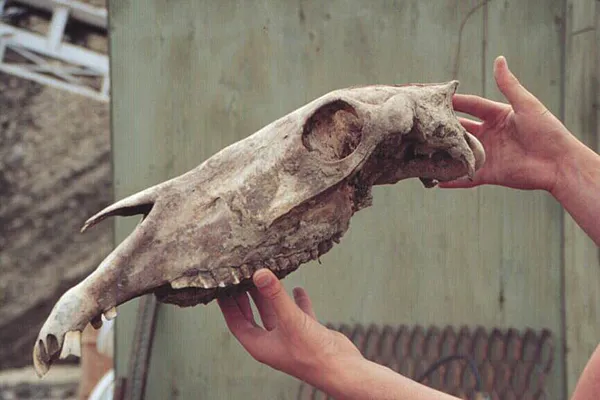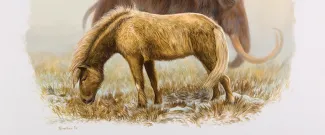Horses were one of the most abundant mammals that roamed the cold, treeless steppe of ice age Yukon. Unlike the steppe bison, which was a relative newcomer to North America, horses and their ancestors have been on this continent for a long time. In fact horses, like the wild ones that we now know best from Africa and Eurasia, originally appeared and evolved in North America. The extinction of horses around 12,000 years ago marks the first time in the last ~55 million years that North America has been horseless.

Palaeontologists have long been studying the evolution of horses, in part because they have a remarkably complete series of species. The earliest known ancestral horse was a four-toed, dog-sized horse that lived in North America around 30 to 55 million years ago. The modern horse form, which includes domestic and wild horses, zebras, and wild asses, evolved around 5 million years ago in North America, and spread out to the other continents near the start of the Ice Age.
Horses were abundant across North America, Eurasia and Europe during the Ice Age. In fact, palaeontologists throughout the 20th and 21st centuries have defined over 50 different species of ice age horse based on the size and shape of their skeletons. In Yukon, most ice age horses were particularly small in size—standing only about 12 hands or 1.2 metres high at the shoulders—suggesting they may be a unique species known as Equus lambei, the Yukon horse. However, recent DNA analyses suggests that all of these various species of ice age horse likely represented regional populations of a single wide-ranging horse species.
The ice age horses in Beringia were remarkably similar in appearance and are genetically related to the endangered Przewalski's horse of the Mongolian steppes. The ice age horses of Eurasia gave rise to the domestic horse, Equus caballus.
Yukon's Ice Age Horse Story

Discovered at Last Chance Creek by Olynyk and Toews.
One of the most significant ice age horse finds in Yukon was discovered in the muck along Last Chance Creek by gold miners Lee Olynyk and Ron Toews. While working their mine with a backhoe, they uncovered a partial frozen carcass of a Yukon horse. The carcass consisted of a large piece of hide, stretching from snout to tail with hair and mane still attached, a partial forelimb with muscle, tendons and bones, and a portion of the horse's internal organs, all preserved by the frozen ground. This spectacular specimen can be seen on display at the Yukon Beringia Interpretive Centre.
Yukon's Other Ice Age Horses
While the typical small-bodied horse was certainly the most abundant horse roaming Yukon during the end of the Ice Age, it was not the only horse species to call Yukon home. During the latter part of the Ice Age, Yukon was home to a unique North American species—the North American "stilt-legged" horse. Stilt-legged horse leg bones are much thinner, suggesting they were much more lightly built than the typical ice age horses of Yukon. Not that much is known about the rare stilt-legged horse. DNA recovered from bones found in Yukon and Alaska has confirmed that stilt-legged horses are part of a group which evolved in, and never expanded beyond, North America. Radiocarbon dates reveal that the stilt-legged horse was gone from Yukon by about 35,000 years ago.
Some fossils of a much larger-bodied horse have also been found in Yukon. These beasts were as large as a draft horse of today. Scientists still don't know how these large horses are related to the smaller, common ice age horses of Beringia.
Want to keep exploring? Check out the Beringian Research Notes on the Yukon horse.

In 2013 scientists extracted and analyzed the complete genetic sequence from a 700,000 year old ice age horse fossil, discovered at a gold mine on Thistle Creek, Yukon. This is the oldest ancient DNA ever recovered in the world!

